“You want the board to move — not the paddle,” said Conor Flynn, my stand-up paddleboarding (SUP) guide.
We were heading downstream on the Roaring Fork River in Aspen, Colorado’s Northstar Nature Preserve, and I was struggling to keep up with Flynn and my partner who, cue eye roll, is as natural at sports as I am awkward.
I considered Flynn’s message as I thrashed my paddle in the wayward water; surely, he was speaking in code.
Like a bowling ball in a lane outfitted with bumpers, I ricocheted from the right side of the river to the left, lifting my paddle out of the water and pushing it into caked-together dirt for support. I could feel the gaze of two women chatting in hushed
tones on a distant bridge.
Unlike SUP in the ocean, the river sport requires a keener sense of navigation and a true awareness of obstacles. If I wanted to keep from zigzagging, or avoid coming down to my knees at the site of protruding rocks, a change in current or another person,
I needed to unlearn my default paddle technique.
“That’s a great stroke, man,” said Charlie MacArthur, the founder of Aspen Kayak & SUP Academy, the company I was paddling with. Outside Magazine credits MacArthur — an extreme sports athlete who’s also an expert skier and kayaker — with developing “techniques
and gear that made SUP accessible to everyone.”
We intercepted MacArthur on his way upstream, and though I’d begun to “go with the flow” a bit more, the compliment was for my partner, who had already advanced to practicing a surf stance on his board.
MacArthur seemed to float. Even though he had just returned from teaching SUP instructors in Japan, he was chatty and radiating vitality.
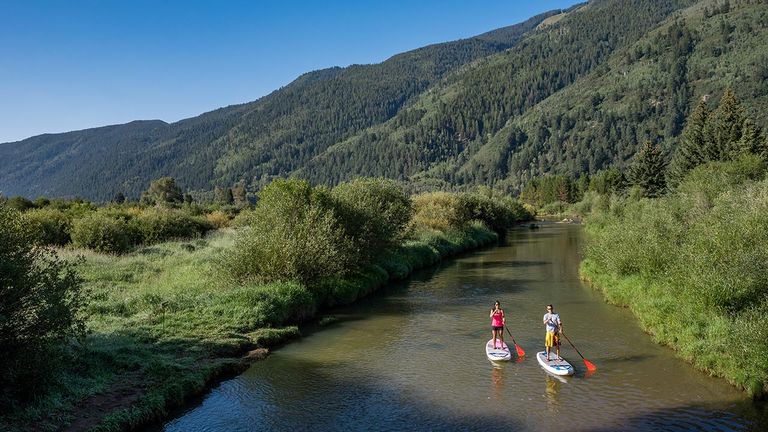 Learn how to stand-up paddleboard in the river at the Northstar Nature Preserve.
Learn how to stand-up paddleboard in the river at the Northstar Nature Preserve.
Credit: 2018 C2 PhotographyThroughout my visit to Aspen, I kept bumping into men and women as impressive and inspiring as MacArthur.
Julia Douglas, the Aspen-based founder of JetSet World Travel and the Axus Travel App (acquired by Northstar Travel Group, the parent company of TravelAge West), says her clients are always surprised by “how hospitable, genuine, joyful and understated
the locals are.”
And that’s what I found, too. The community of about 7,000 full-time Aspen residents are consummate outdoorspeople happy to share the slice of alpine paradise they work hard to live in.
In addition to impressive and entrepreneurial year-round residents, celebrities and corporate executives consider Aspen their retreat, as well. At least 50 billionaires own homes in Aspen — and real estate prices reflect that. Last year’s annual list
of America’s Most Expensive Zip Codes, compiled by Altos Research for Forbes, lists Aspen as the No. 12 most expensive destination (median home price: $5,849,184). Neighboring town Woody Creek holds the No. 7 spot with a median home price of $6,651,269.
For reference, Los Angeles’ most expensive zip code — 90210 — is No. 8 on the list.
“The wealth in our community supports urban culture to exist in this rural setting,” said Nina Gabianelli, vice president of education and programs for Aspen Historical Society.
Indeed, if you were plucked from your home and dropped in downtown Aspen, you might not realize you’re about a four-hour drive from Denver in a remote location surrounded by the Rocky Mountains, some 8,000 feet above sea level.
“Aspen is ‘at the end of the road’ off Highway 82,” Douglas said. “Once you pass through town, you continue up Independence Pass over the Continental Divide without passing through another town for more than an hour.”
Yet, in the span of about six blocks, there are some 200 art galleries and retail boutiques, 80 restaurants and bars and eight cannabis dispensaries. The town’s music venue, Belly Up, only fits 450 people yet attracts top-tier acts, from dance-rock band
LCD Soundsystem and indie-rock group Cold War Kids to rapper T.I. and DJ Diplo (and that was this past winter alone).
“Aspen is the only destination in the world with such a cosmopolitan cultural community directly at the base of a mountain,” said Brian Payntar Harris, founder of Aspen Travel Advisors. “Add to that a highly degreed, traveled and multilingual population,
and you have a very special place indeed.”
And it’s clear that word is spreading. The Aspen Chamber Resort Association Marketing Fund passed in 2010, and destination marketing began in 2011. Summer occupancy grew from 56 percent in 2010 to 72 percent last year. Winter occupancy (71 percent) was
up by 10 percent compared to 2010.
Travel advisors have a lot to gain when it comes to Aspen. According to Jill Canning, director of travel agency sales for Ski.com, Aspen Snowmass vacations for Ski.com booked through a travel advisor “averaged 92 percent higher sales than consumer direct
bookings.”
And while it’s possible to create midrange vacations utilizing the destination’s condominium and rental properties, there’s no denying that high-end travelers are a perfect match for Aspen.
“We focus exclusively on the high-end market, and Aspen certainly caters to these types of travelers,” Douglas said.
A Renaissance
Aspen did not develop as an outdoor utopia, cultural hub and epicenter of wealth by accident.
Though the Ute people claim to have always resided in the Roaring Fork Valley, Aspen attracted new residents in 1879, three years after Colorado became a state. Silver was discovered, and soon, Aspen was producing one-sixth of the nation’s silver.
Aspen is the only destination in the world with such a cosmopolitan cultural community directly at the base of a mountain.
I learned this like I learned most other things in Aspen: outside. In this case, I was ascending the Hunter Creek Trail with Grayson Bauer, a naturalist with Aspen Center for Environmental Studies (ACES), who pointed out dynamite markings on rock while
explaining that the trail we were walking on was originally developed for wagons.
I wondered aloud if the men who created the trail were exploited, but Bauer explained that it was the contrary. At its peak, Aspen was home to more than 12,000 citizens and enjoyed public electricity and its own opera house and hotel (Wheeler Opera House
and Hotel Jerome, respectively).
Sadly, Aspen went bust in 1893 following the demonetization of silver by the U.S. government. For decades, fewer than 1,000 residents remained in Aspen — until it was rediscovered, embraced and reimagined by Walter Paepcke, chairman of the Container Corporation
of America, and his wife, Elizabeth. The Paepckes are local legends in Aspen and widely credited with laying the groundwork for what the town is today.
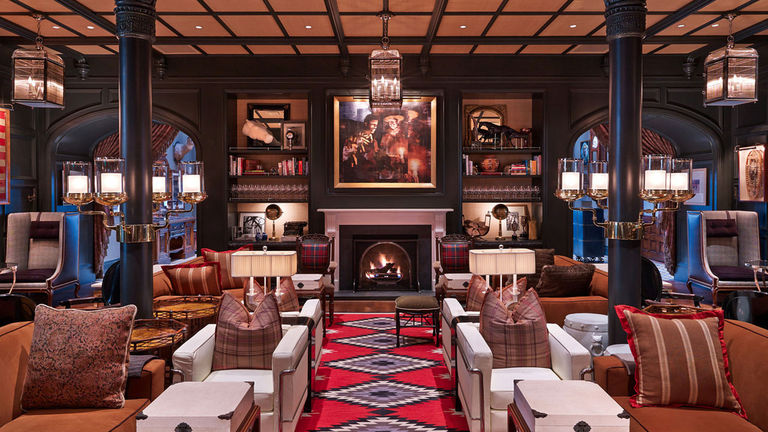 Hotel Jerome, Auberge Resorts Collection, is one of several sites built when Aspen was a prosperous silver mining town.
Hotel Jerome, Auberge Resorts Collection, is one of several sites built when Aspen was a prosperous silver mining town.
Credit: 2018 Hotel Jerome, Auberge Resorts CollectionPaepcke founded Aspen Skiing Company in 1946 and dedicated the world’s longest chairlift by 1947. But he wanted to position Aspen as a cultural center, too: In 1949, he invited a group of artists and intellectuals to town for the Goethe Bicentennial Convocation
and Music Festival to honor the life and work of German writer Johann Wolfgang von Goethe. Two-thousand people attended, and later that year, Paepcke founded the Aspen Institute for Humanistic Studies.
Many organizations grew out of the Aspen Institute, such as the Aspen Music Festival and School, Aspen Center for Physics and the former International Design Conference of Aspen.
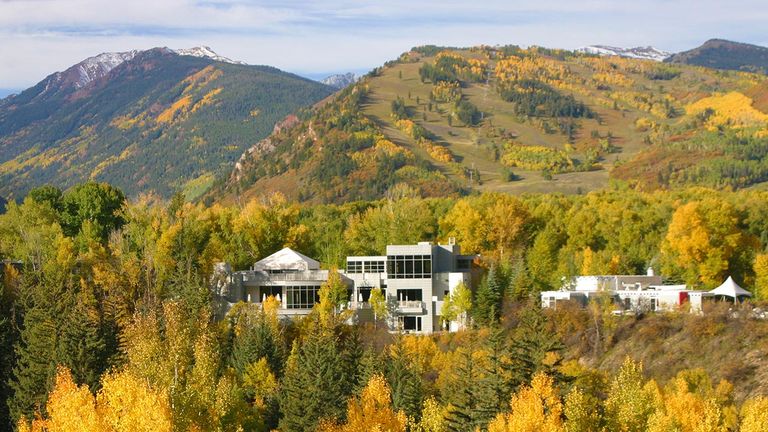 Aspen Meadows, Home of the Aspen Institute, is a world class meetings destination surrounded by mountains.
Aspen Meadows, Home of the Aspen Institute, is a world class meetings destination surrounded by mountains.
Credit: 2018 Aspen Meadows, Home of the Aspen InstituteMind, Body and Spirit
The Paepcke era gave rise to the “Aspen Idea” that the area could be the ideal location for the integration of the mind, body and spirit for the greater good.
“As a community, if you’re each whole and at your best, then you’re better able to help others be their best,” said Gabianelli of Aspen Historical Society. “As a community, we live and support each other.”
Spend any time in Aspen, and you’ll quickly learn that the Aspen Idea remains both a magnet and a guiding light to its citizens and visitors.
“This philosophy is why I’m still here,” said Harris of Aspen Travel Advisors, who moved from Chicago to Aspen in 1999. “It’s a fundamental tenet of what the Paepckes envisioned for the new Aspen: a multidisciplinary college of nature, drawing the best
minds from around the world.”
Aspen is also not a place that rests on its laurels. Thanks to a discerning clientele and a competitive marketplace, old concepts are routinely replaced by innovative businesses, from an underground feminist events space contained in the walls of Aspen’s
oldest building to a wellness hub featuring hemp-oil treatments and a post-massage oxygen bar.
In Aspen, visitors can strengthen their mind, body and spirit in both new and time-tested ways.
Mind
When it comes to strengthening the connection between the mind and body, few things are better than yoga and self-care. In Aspen, the bar is set high — in 2014, Travel + Leisure readers named St. Regis Aspen’s Remede Spa the No. 1 Spa
in the U.S. But now, there’s more.
Near Aspen Mountain’s Gondola Plaza is the new location of O2, which features a white-and-gray color palette that helps create a breezy and chic vibe. The space features a boutique of on-trend athleisure digs, such as Stella McCartney sneakers; a Pilates
and yoga studio with views of Aspen Mountain; and three treatment rooms. My CBD-oil body work was unlike any I’ve ever received — instead of going through a rehearsed choreography of motions, my therapist applied numerous techniques to get my hips,
shoulders and even ribs in order. Post-massage was just as good, featuring an oxygen bar to complement tea and snacks.
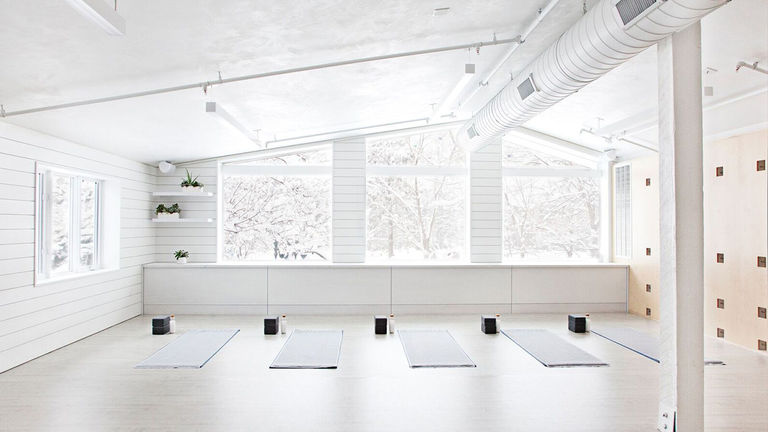 A new location for wellness center O2 features an athleisure boutique, treatment rooms and a Pilates and yoga studio with views of Aspen Mountain.
A new location for wellness center O2 features an athleisure boutique, treatment rooms and a Pilates and yoga studio with views of Aspen Mountain.
Credit: 2018 O2Another newly relocated wellness destination is Aspen Shakti, which communicates a warm, whimsical vibe thanks to bold use of color, hand-painted spiritual quotes on walls and layering of eclectic pieces throughout. Aspen Shakti offers treatments and
yoga and meditation classes, ranging from a classic vinyasa flow to Thug Yoga (a “gateway” class that includes rap and EDM music and a beer from Aspen Brewing Company).
The yoga room is among the most beautiful I’ve practiced in, featuring one stone wall and one mirrored wall accented by cascading sparkling lights — but most folks won’t want to miss the opportunity to practice with Aspen Shakti at the 11,212-foot summit
of Aspen Mountain. The hourlong, all-levels summer classes kick off June 18 and are offered Monday through Friday at 10:30 a.m. Participants are required to purchase a $35 gondola lift ticket, though the class itself requires only a $5 donation.
“Mother Nature is hugely in her magnificence in Aspen, so when we take a moment to slow down, connect and bring the body, mind and spirit into alignment, we naturally feel the sensation of connection, possibly even to a larger source and spirit,” said
Lucy “Lea” Tucker, who handles public relations and marketing for Aspen Shakti. “I believe this sense of connection, oneness and aliveness is exactly the untouchable feeling upon which Aspen was founded.”
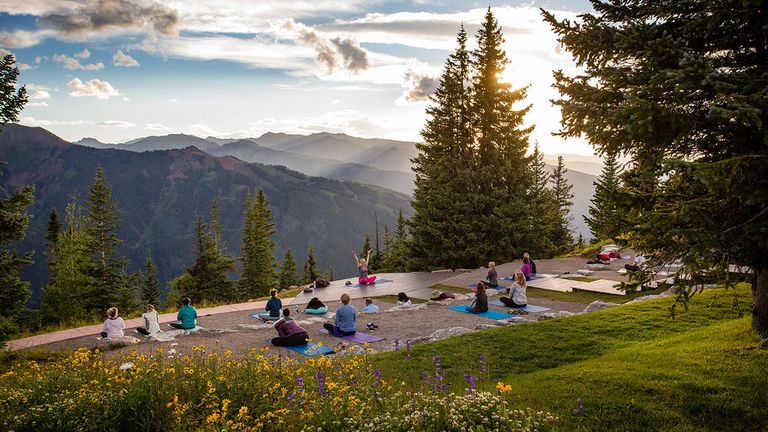 Yogis can practice at the top of Aspen Mountain during the summer months.
Yogis can practice at the top of Aspen Mountain during the summer months.
Credit: 2018 Jeremy SwansonAspen was also created to be a destination for intellectual pursuits, music and the arts. Guests at Aspen Meadows, home of the Aspen Institute, can trace the city’s relationship with the Bauhaus art movement to artist Herbert Bayer, who designed the property
and whose work can be found throughout. Surrounded by mountains and trees, the campus-like Meadows is ideal for group meetings and has hosted nearly every brilliant mind alive, from Michelle Obama to the Dalai Lama. Today, Aspen Institute holds numerous
workshops and seminars and, most notably, the Aspen Ideas Festival, in partnership with The Atlantic magazine, in June.
And while there are numerous art galleries around town, the No. 1 place to view contemporary work is Aspen Art Museum, which was relocated in 2014. The new building by Pritzker Prize-winning architect Shigeru Ban houses just the right amount of art, illuminated
by thoughtful docents (ask for Michelle Dezember). Be sure to visit the sculpture garden on the rooftop deck, which is also the setting for So cafe. With its front-row view of Aspen Mountain, a new menu each week and a strong matcha latte, the cafe
is the ideal place to reflect on the art below.
Of course, this is Colorado and, as of 2013, there have been other ways to expand the mind here. Aspen has embraced the legal standing of cannabis with eight unique shops. For a vibe that complements the town’s many luxury boutiques, head to Silver Peak,
one of the first dispensaries to embrace a high-end and conceptual retail space for the sale of cannabis and related paraphernalia.
For those who prefer to receive therapeutic benefits via shopping, the amount of high-end clothing stores, ranging from Lululemon to Louis Vuitton, is staggering. Because of Aspen’s affluent clientele, many say its thrift stores — such as The Little Bird
— are among the best locations for scoring deals on last season’s designer pieces. Another shop that’s worth a stop is Kemo Sabe, a western retailer that sells (and brands) high-quality cowboy hats and boots. Though Kemo Sabe has shops in Vail, Colo.,
and Las Vegas, the Aspen location recently moved to a two-story space, which includes Americana memorabilia and a vintage bar dating from the 1800s.
Hotel Updates
Aspen Meadows, Home of the Aspen Institute
Completion Date: This summer
New Social Area: Guests of the 98-room, 40-acre Bauhaus property will enjoy a new reception area, a pavilion, additional restaurant space and an outdoor deck that promises to be one of the best spots in all of Aspen to catch the sunset.
Why It Matters: With 22,000 square feet of meeting space, Aspen Meadows is the premier events venue in town. The newbuild will help elevate the space and diversify its social options even further.
Hotel Jerome, Auberge Resorts Collection
Completion Date: This summer
New Rooms: A newbuild adjacent to the historic 93-room hotel features two, 2,000-square-foot, three-bedroom suites. The residential-style rooms will feature views of Aspen Mountain.
Redone Courtyard: A newly designed and landscaped space — featuring a revamped swimming pool — will be ideal for weddings and apres-ski events.
Social Space: Adjacent to the newbuild and courtyard is the hotel’s 140-year-old former Aspen Times building. The building was renovated to serve as an event space, while its basement will house an underground lounge named Bad Harriet, which will honor strong, newsworthy ladies of the past and present.
Limelight Snowmass
Launch Date: Winter 2018
How You Know It: Limelight Aspen, a 99-room hotel in the heart of downtown, is a local and guest favorite, offering a high-value stay, a pet-friendly policy and amenities such as included breakfast and free use of the hotel’s two Audi SUVs.
What to Expect: The property will offer the same perks the brand is known for, plus ski-in, ski-out access to Snowmass Mountain.
W Aspen and the Sky Residences at W Aspen
Launch Date: Spring 2019
What to Expect: The 88-room property will be located on the site of the former Sky Hotel at the base of Aspen Mountain. Guests can expect W’s trendy design and buzzy vibe, which can be best soaked up at the hotel’s rooftop and pool, underground speakeasy and quirky guestrooms.
Why It Matters: This is W’s first alpine hotel — and certainly Aspen’s first hotel of this kind.
Maybe it’s the altitude or maybe it’s my love of the outdoors, but when my hiking guide told me to lick my finger and touch a tree, I found myself doing just that. I swiped downward on the bark, which produced a tan chalk on my finger.
“This is like the Aspen tree’s sunscreen,” said ACES’ Bauer, who, during a one-hour hike, taught me more about trees than I’ve ever learned in my entire life.
Nature here is amazing: The tree line reaches for infinity. Treetops seem to brush the clouds.
For those who want to understand Aspen’s environment, visiting ACES’s 25-acre nature reserve at Hallam Lake — and chatting with an on-site naturalist — is a must. Kids and adults alike will enjoy walking around the lake, where they might spot a coyote,
fox or bear. An ambassador of the space is an injured golden eagle that, according to Bauer, has “retired in Aspen, which is everyone’s dream.”
In the winter, one can snowboard and ski at four resorts with one all-inclusive pass. There’s iconic Aspen or “Ajax” Mountain, recommended for intermediate and advanced skiers; Buttermilk, which is ideal for beginners and intermediates (and especially
popular for uphill skiers); Aspen Highlands, home of the beloved Highland Bowl, a double-black diamond bowl that requires a hike to reach but delivers with numerous runs; and Snowmass, the area’s largest mountain with varied terrain perfect for both
beginners and experts.
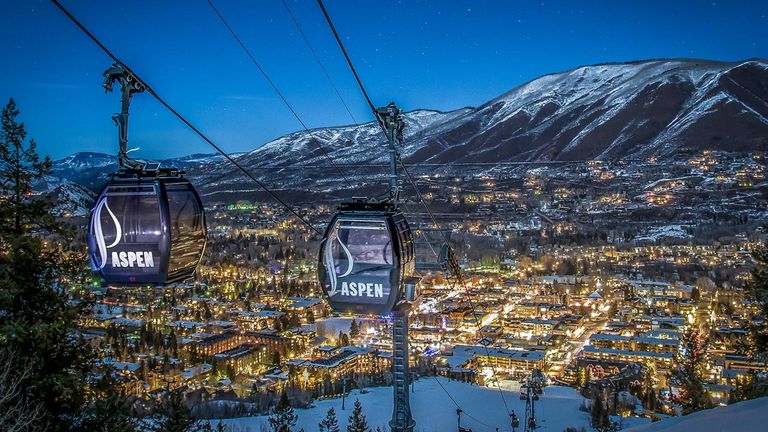 With one pass, visitors can ski at four unique resorts.
With one pass, visitors can ski at four unique resorts.
Credit: 2018 Zach MarazitiDuring the spring, fall and summer, there’s hiking, biking, SUP, fly-fishing, four-wheel driving, whitewater rafting and anything else people come up with.
The Breathtaker Alpine Coaster, launched during the 2017-2018 winter season in Snowmass, travels through more than 1 mile of forest at up to 28 mph. The coaster is part of the new Lost Forest adventure course; the rest of the park will open this summer
and consists of eight ziplines, a climbing wall, a ropes course and nature trails.
While locals also recommend visiting Independence Pass, Maroon Bells is the No. 1 bucket-list item on most Aspen itineraries, and it perfectly encapsulates the range of activities that can be done in the area. Photographers dream of capturing the two
peaks (aka “the Bells”) framed by trees and replicated in Maroon Lake. Some prefer to trace the view from every angle as they walk the mile-long perimeter of Maroon Lake, especially during the fall, when the trees brighten with golden colors.
Bauer recommends hiking to Crater Lake, a 3.6-mile roundtrip trail that delivers equally impressive views.
“Without a terribly difficult hike you get to see marmots and pika, which normally live in rather remote places,” he said. “It also gets you away from the crowds and puts you at the foot of the Bells, which are bigger than can be described.”
Another popular activity is a 12-mile downhill bike ride from Maroon Bells, a half-day activity that can be arranged by local tour operator Blazing Adventures.
The most intrepid and fit of them all can attempt summiting North and South Maroon Peaks, two of the hardest “fourteener” (14,000-foot peaks) hikes in all of Colorado.
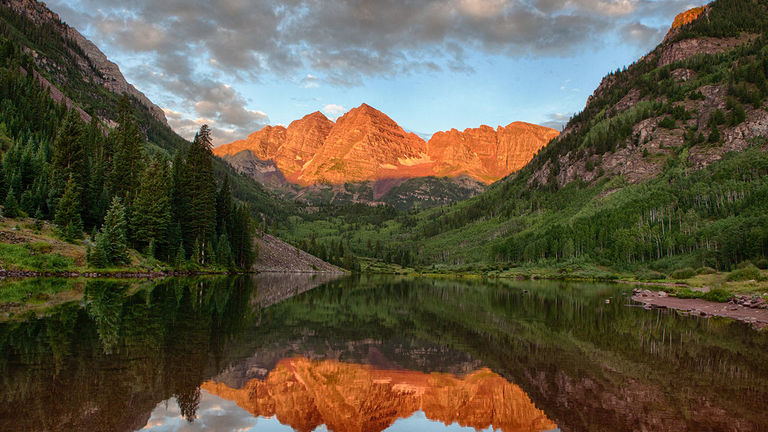 Maroon Bells is the No. 1 most photographed destination in Colorado.
Maroon Bells is the No. 1 most photographed destination in Colorado.
Credit: 2018 Mary Sue BonettiFood and Spirits
Aspen’s mind-body-spirit philosophy puts a strong emphasis on the health of the individual. Some eateries almost exclusively serve nutritious fare, such as Jus Aspen, a smoothie and salad spot that opened in early
2017, and Spring Cafe, a bright and casual organic vegetarian eatery that has most food allergies covered.
More common are restaurants that include a full range of healthful and decadent choices. White House Tavern, located in a historical miner’s cottage, is one of Aspen’s busiest restaurants, and it toes the line well — on one end of the spectrum is the
Macho Salad, filled with rotisserie chicken, dates, freshly shucked corn, goat cheese and avocado; and on the other end is the restaurant’s famous Chicken Sandwich, starring a hulking slab of fried chicken topped with spicy slaw in between thick homemade
torta bread.
While White House harks back to days gone by, Meat + Cheese features a modern look that puts its dairy and booze at the heart of the restaurant. Don’t leave without ordering the restaurant’s exceptionally smooth Jalapeno Margarita, made with a dangerously
delicious pineapple-and-jalapeno vodka.
Aspen locals are proud of their apres-ski (or apres-hiking, -biking, etc.) options — and since these social drinking hours typically follow intense physical activity, it’s basically a wash. There’s the bar at Steakhouse No. 316, which may be the No. 1
place to bring a date thanks to moody lighting and a sultry aesthetic, and The Little Nell’s Ajax Tavern, which is located slopeside and serves a wagyu cheeseburger with a side of truffle fries, beautiful views and epic people watching.
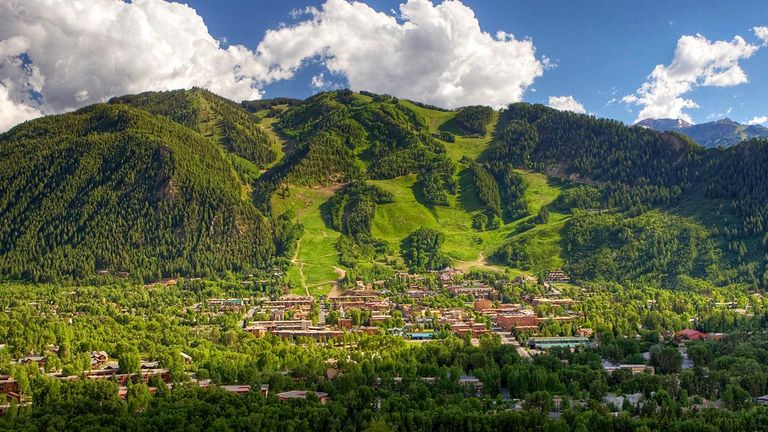 Though a small mountain town, Aspen is home to some 80 restaurants and bars.
Though a small mountain town, Aspen is home to some 80 restaurants and bars.
Credit: 2018 Jeremy SwansonTo truly indulge, time a trip with the Aspen Food & Wine Classic, which takes place in June and organizes wine tastings, cooking demonstrations with celebrity chefs and more.
Fans of “Fear and Loathing in Las Vegas” author (and former Aspen resident) Hunter S. Thompson will want to check out his old haunts. There’s J Bar at Hotel Jerome, Auberge Resorts Collection, a storied watering hole famous for selling spiked milkshakes during Prohibition and later
serving as Thompson’s unofficial office. It’s even easier to imagine the counterculture hero fitting in at Woody Creek Tavern, a kitschy dive featuring year-round multicolored Christmas lights and walls slathered in Polaroids.
But this is Aspen — and even an homage to a rabble-rouser is best paired with physical activity and immersion in nature.
Locals say that biking to the tavern is a must — as is cross-country skiing (or snowshoeing or sleighing) to Pine Creek Cookhouse at the base of the Elk Mountains.
And I can see why: Trekking through the snow or biking alongside trees to reach a venue in the wilderness is just what you do here. It’s the idea of Aspen.
5 Tips for Selling Aspen
Jill Canning, director of travel agency sales for Ski.com, knows that selling mountain travel can be a bit daunting to travel advisors who aren’t mountain buffs themselves.
“They’re booking the world, and they get a call for Aspen, and they don’t know where to start,” she said.
Following are tips from Canning; Julia Douglas, founder of JetSet World Travel and the Axus Travel App; and Brian Payntar Harris, founder of Aspen Travel Advisors, on what to know about selling Aspen.
1. Airlift is great.
“During the winter season, Aspen airport has a minimum of 220 flights per week,” Canning said. “There are also nonstop flights from Houston, Dallas, Los Angeles, Atlanta, Minneapolis, Chicago, Phoenix, Salt Lake City and San Francisco, and nine daily flights from Denver.”
2. While a car rental could be good for exploring outside of town, don’t bother if sticking to Aspen.
“There are bikes to rent, community bikes to borrow and the Downtowner, which offers tip-based transportation by electric cars within the city core,” Douglas said. “Plus, most luxury hotels also offer transport in their resort fleet.”
3. Consider a consolidator to create an all-inclusive package that is entirely commissionable.
“A travel agent booking through Ski.com adds the multiple components to a ski vacation,” Canning said. “We book not only the property; we add on lift tickets, transfers to and from the airport, rentals, lessons and even air and trip insurance, making a commissionable package have a much higher value than the agents doing it themselves and booking lodging only.”
4. There’s a limited supply of hotel rooms, so don’t shy away from vacation rentals — especially for midrange clients.
“You can access commissionable rates for the vacation rental market through a consolidator,” Harris said.
5. Book ahead.
“The top tables book up quickly, and the restaurants are exceptional for a small mountain town,” Douglas said.